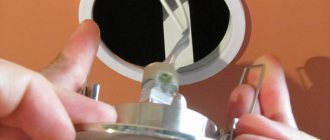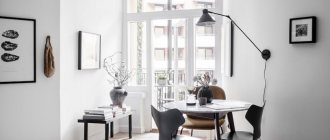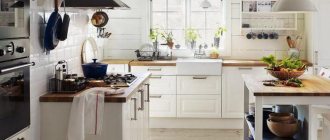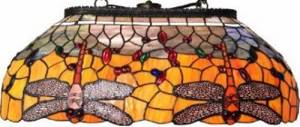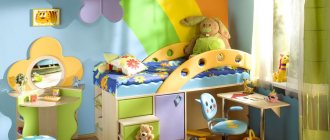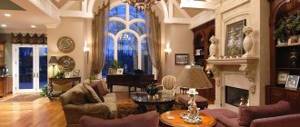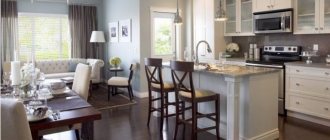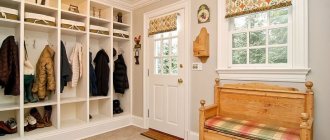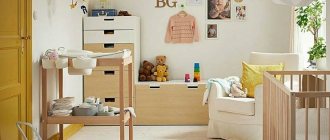Peculiarities
Built-in furniture lamps consist of an external decorative part and an internal functional one. Their installation is planned in advance by the owners of the apartment or house. Lamps are ordered together with the furniture, installation is carried out during assembly. If you need to install lighting in already finished furniture, this is quite possible if you have basic skills in working with electrical equipment.
The main purpose of recessed lamps is to create additional lighting. In addition, the devices perform auxiliary functions: dividing the room into zones, highlighting individual decorative elements, creating the illusion of space, and emphasizing the beauty of the furniture. Other advantages of recessed luminaires include:
- the device looks aesthetically pleasing, being on the same level with the furniture design elements, additional electrical equipment is located out of sight;
- the ability to illuminate individual areas of the room and accentuate details;
- low power consumption;
- a large number of lighting points helps reduce the number of shadows and optimize space;
- wide range of shapes and colors.
Flaws:
- installation of lamps is difficult and requires skills in working with electrical materials;
- you need to choose places for lighting the furniture in advance (when planning the design of your apartment);
- Transfer of lamps is undesirable; replacement of the damaged surface will be required.
Lighting fixtures built into furniture are subject to increased fire safety requirements. If lamps are used that heat up during operation, they must be enclosed in a heat-resistant housing.
Lighting in the kitchen: features
Kitchen lamps under cabinets
Truly comfortable working conditions in the kitchen depend not only on comfortable and functional furniture, but also on lighting, which should be moderately bright and illuminate all areas of the work area, even if it is a mini-kitchen. Modern interior designers often completely abandon a chandelier in the kitchen, preferring to place several point lighting sources around its perimeter. This is a good option as these few lamps provide better illumination of the work area, but it is not enough.
You can find out about kitchen design with pendant lamps here.
Light sources need to be placed not only based on the design concept, but also in the right places. For example, an additional light bulb above the stove will be superfluous, since the lighting from the hood hanging above the stove will be sufficient.
Lamps may be different
When installing new lighting fixtures in the kitchen, you need to take into account that powering all the built-in lamps from one source may be impractical, inconvenient and even dangerous. Of course, modern lamps from built-in small lamps do not create heavy loads on the wiring, but if the wiring is old, it’s better to be safe.
In addition, in this case the issue of convenience is more relevant. For example, if your kitchen has a chandelier, built-in lamps in the cornice, and even lamps built directly into wall shelves or cabinets, it is more rational to make three separate switches.
You can find out how to combine a room with a loggia here.
Before you radically change the lighting system in the kitchen, you need to remember a few nuances:
- If you are planning to install spotlights, do not skimp and choose those with a movable head , so you can independently adjust the direction of the light;
- When ordering a headset or purchasing a ready-made model with backlight, ask the seller what kind of backlight is installed. Some imported lamps are equipped with special lamps with non-standard sockets . It happens that you can only purchase spare lamps abroad, from the manufacturer, and although in the age of high technology such goods can be ordered online, delivery may take a long time, and the cost of lighting a kitchen set will ultimately be prohibitive;
- As for standard lamps for lamps, do not skimp on quality : in the kitchen you will have to use lamps more often than in other rooms, and low-quality cheap lamps will wear out their working life very quickly.
What can be used for kitchen lighting
Traditional incandescent lamps have long turned into archaism and remain in use only because of their cheapness and old lamps, the design of which is designed for an ancient screw base. Today, people are switching en masse to halogen and LED furniture lamps for the kitchen, considering the cost of re-equipping cabinets and lighting systems as a relatively small price to pay for significant benefits and advantages:
- The design of the kitchen has changed; by installing kitchen furniture lamps on cabinets, you can seriously refresh the “appearance” of the kitchen without major alterations and costs;
- The principle of lighting organization has changed. With the help of LED lamps, it became possible to illuminate any corner, drawer or cabinet without losing useful space and without cluttering the kitchen with dozens of meters of wiring.
LED lamps have an order of magnitude greater light output, which means that with the same energy consumption you can get ten times more light in the kitchen. Even the once vaunted halogen lamps remain in the kitchen only to create a warm, sunny atmosphere, and even then, the latest models of LED lamps are displacing halogen lamps from this area as well.
Important! But even an increase in the number of lighting points does not lead to excessive energy consumption, but provides significant savings due to the sectoral principle of arranging LED lamps.
In the case where one powerful ceiling lamp is used in the kitchen, electricity consumption is at the same maximum level, and practically nothing can be done about it. But you can change the scheme of using LED lamps - instead of one large one, use a dozen small ones built into furniture cabinets. It turns out that when working in the kitchen, the lighting system illuminates only that area of the room where the person is directly located; the rest of the furniture LED lamps are turned off or operate in economy mode.
Lighting furniture cabinets using LED lamps
Of course, the lighting system with the help of furniture LED lamps has become much more complex and even more intelligent. In order to get a beautiful and attractive design of a kitchen furniture set and at the same time provide the most efficient lighting, it is not enough to replace the ceiling lamp with several LED lamps. It is necessary to redesign and use specialized models of LED lamps, “tailored” to a specific type and method of lighting the kitchen area.
To organize lighting, several basic models of LED lamps are used:
- Ceiling raster lamps that provide a flow of diffused light in the background, as a rule, these are LED lamps with the ability to stepwise adjust the brightness of the light;
- Overhead furniture lamps for the kitchen, installed on the upper tier of furniture;
- Spot or strip LED lamps mounted at the junction between the wall and the bottom of a furniture hanging cabinet;
- Recessed spotlights used to illuminate small areas of the work surface, for example, the cutting area of a countertop or hob surface.
Interior lamps and luminaires used to illuminate the interior of a separate furniture cabinet or hanging drawer are extremely popular. Battery-powered lights with motion sensors are best suited for these purposes.
Important! You cannot use halogen and fluorescent lamps to organize interior lighting of furniture cabinets in the kitchen; in addition to high heat generation, some models contain mercury and can release metal vapors when destroyed.
In addition to LED lamps located on wall cabinets, a stand-alone lighting system for the most important objects in the kitchen is usually used. For example, this could be a pendant option to illuminate the dining table in the kitchen, or a lamp that provides a weak directional flow to illuminate the refrigerator. As practice shows, an LED spotlight, which helps to navigate in the dark in the kitchen, is wildly popular among those who like to check the contents of the refrigerator at night.
Lighting options
Built-in furniture lamps are installed for additional lighting purposes, to highlight individual decorative details, and create a cozy atmosphere in the house. When planning the placement of furniture in an apartment, you should pay attention to the proper combination of lighting devices.
Organization of various types of lighting:
- Recessed lights in the work area. A bright light should provide the necessary illumination of the working surface. An additional lighting device is located above the table, which allows you to save your eyesight during prolonged work at the computer.
- Accent lighting is located in certain parts of the apartment that need to be especially highlighted. Recessed furniture lamps are located away from the eyes, their light is directed towards interesting elements of the interior: objects of art, stylish pieces of furniture, unique items or photographs.
- Decorative lighting does not carry a functional load. The light sources are built-in colored lamps, which highlight parts of the furniture favorably as a decorative element. LED strips are placed on the lower part of the furniture set, creating the feeling of externally bulky pieces of furniture floating in the air.
- Festive lighting is bright, original, positive. Designed to create a festive atmosphere during family celebrations. Lamps built into furniture are turned on in anticipation of a festive event.
Installing a dimmer—power switch, dimmer—creates additional opportunities for decorative lighting and saves energy.
Kitchen lighting schemes with furniture lamps
Lamps for lighting furniture drawers and kitchen furnishings are traditionally divided into three groups according to their design and installation method:
- Hanging or surface-mounted lamps, the installation of which does not require remodeling or modification of expensive kitchen furniture;
- Built-in structures installed inside furniture drawers with minimal alteration;
- Mortise lamps are most often mounted in the bottom parts of hanging structures located above the tabletop.
By design, these can be spotlights or strip lights. In some cases, using LED strips, entire surfaces that emit light are formed, but it is difficult to call such a solution successful.
According to experts, any high-intensity spotlights must be covered with diffuse softening glass. The LED produces a high temperature and intensity of luminous flux, even if you look at the luminous point of the LED with peripheral vision, the eye still receives very strong irritation.
Mortise and recessed furniture lamps
Most often, when talking about backlight lamps installed on furniture drawers, we mean classic point light sources, which are widely used for organizing distributed lighting, photo. But there are some peculiarities and differences.
Firstly, if ordinary halogen lamps can be installed on the kitchen ceiling, which illuminate the hall, living room or any other rooms, then in the kitchen, mainly LED lamps are embedded into furniture cabinets. There is only one reason - the low heat emission of the lamp, compared to a halogen lamp, does not destroy the wood, chipboard or plastic from which the cabinet and cladding are made.
Secondly, LED lamps have low inertia, they can be turned on at any frequency, an unlimited number of times.
Thanks to this, it became possible to use LEDs with built-in infrared motion sensors. When a person moves around the kitchen, thanks to sensors, the LEDs can turn on and off according to a pre-programmed pattern. In appearance and shape, such lamps can be made in the form of built-in lanterns, or even entire panels.
Any insertion of lamps, sockets, speakers has an extremely negative effect on the quality of furniture cladding, so lighting manufacturers offer more advanced built-in models of LED panels in the form of stylized supports.
Most often these are small flat lanterns, round or rectangular in shape, glued to the bottom of furniture drawers. In addition, using dimmers or programmable controllers, you can easily control the brightness of the light. For example, if you don’t like the “light music” performed by LEDs that respond to motion, you can turn on only the necessary lamps and smoothly adjust the brightness of the light.
The group of built-in light sources also includes corner lamps. They are installed at the junction of the bottom of the furniture cabinet and the wall. The simplest schemes involve the use of LED strips and strips glued to a reflective surface, and even fluorescent lamps.
The most stylish models are designed in the form of supports or struts, made of metal and heat-resistant plastic with built-in halogen lamps. This shape and location of the lamp is very convenient for installing a hidden electrical outlet - there is no need to cut furniture cabinets or tiles on the wall.
It's no secret that kitchen cabinets are always filled with a large number of items, which are quite difficult to sort out in poor lighting. For these cases, you can install linear lamps or a strip of LEDs covered with plastic.
For particularly difficult situations, manufacturers recommend using portable flashlights with adjustable direction of light flow.
Surface-mounted and wall-mounted furniture lamps
The largest group of lamps, lanterns and fixtures installed on kitchen furniture are overhead models. The most popular and easiest to implement method involves installing point devices on the top edge of furniture drawers and cabinets.
In this case, the lamps make it possible to provide a directed flow of light to areas of the kitchen adjacent to the countertop, hob and table. Such lamps are always equipped with rotating reflectors, allowing you to adjust the direction and angle of incidence of the light flux. Due to the large distance and dispersion of the light flux, halogens and LEDs are mainly used in such designs; fluorescent lamps are ineffective.
Overhead lamps can be designed in the form of LED strips of different colors, illuminating the upper and lower belts of furniture cabinets.
The most difficult thing is to organize the correct lighting of the kitchen table; with any arrangement of the lamp, vertical or wall-mounted, shading appears on the tabletop, which is not very convenient, especially in the evening and on a cloudy day. Many experts agree that the best solution in this case is to use a classic ceiling chandelier or a lamp with a traditional umbrella shade suspended above the table. To preserve and complement the impression, such models use halogen lamps with a warm, soft glow that imitates an incandescent lamp.
Placement methods
Options for installing furniture lamps for different rooms have their own characteristics. Depending on the functional load, waterproof devices with a directional light source and a diffused radiation flux are used. The requirements for lamps in the work area are to create the necessary illumination in specific places; in recreation areas, to provide conditions for relaxation.
Main types of furniture profiles, characteristics, application
Recommended placement of recessed lighting fixtures in the kitchen area:
- spotlights illuminate the stove, placing the appliances in the hood;
- the additional light source above the sink must be enclosed in a waterproof housing;
- installing lamps on the bottom surface of wall cabinets improves the lighting of the cutting table;
- additional lighting above the wall cabinets illuminates the façade of the kitchen unit.
Study or living room:
- a furniture lamp is installed above the working surface of the desk;
- illumination of bookcases, cabinets and shelves will allow you to quickly find a book;
- placing lighting fixtures at the bottom of upholstered furniture emphasizes its elegance.
Children's room:
- with the help of built-in lamps the room can be divided into work, play and sleeping areas;
- spot LEDs highlight the most interesting interior items: a living corner, a playground, favorite posters, photographs;
- in the dark, the built-in device is used as a night light.
Recessed lamps in the bedroom create a romantic atmosphere and a relaxation zone using dim diffused light. Lighting devices are installed on bed bases, above the mirror, and illuminate deep cabinets. Sliding wardrobes are equipped with lighting on the upper part of the internal walls. The light falls on clothes hanging on hangers. In the bathroom, recessed lamps are used for additional lighting of the mirror, bathtub, and shelves with hygiene items.
Master class on installing halogen spotlights on a wardrobe
This article describes step-by-step the process of installing and connecting halogen lighting in a wardrobe, and also provides recommendations for selecting the cross-section and permissible wire length for connecting 12-volt lamps when using an electronic power supply.
To power halogen furniture lighting, a voltage of 12 volts that is safe for humans is often used, since touching such a bare wire is practically not felt. Despite the low power of the lighting fixtures (in our case, the total power of the lamps is 60 W), the current in such circuits is much greater than in 220-volt circuits of similar power. Let's calculate the current in the primary circuit of the power supply (220 V). In our case, the current is 60 W/220 V = 0.27 A. The current in the secondary circuit (12 V) is 60 W/12 V = 5 A.
As you can see, the current in the secondary circuit is 18.5 times greater than in the primary circuit. Therefore, it is necessary to carefully select the cable cross-section for this type of lighting. In selecting the cross-section, it is also important which transformer is used to reduce the voltage: electronic or induction. In our case, an electronic power supply is used. For such a unit, the permissible length of wires in the secondary circuit (12 V) should not exceed two meters.
To select the wire cross-section for the secondary circuit, use the instructions in the documentation for the transformer, or use the values given in this table.
Table for selecting the cross-section of a copper cable up to 2 meters long, depending on the total load power:
Additional equipment
When purchasing a recessed lamp for furniture, you need to check the presence of additional elements included in the kit. Before starting installation, you need to take the necessary measurements. The electrical cable must be long enough to safely connect to the power source.
Variety of furniture panels, their advantages and main parameters
| Lamp type | Required materials for installation |
| LED lighting fixture | 2 m cable with mini plug, 130 mm profile for hiding the wire, touch or mechanical switch, transformer, decorative plugs |
| Halogen light source | Copper two-core wire with a cross-section of 0.75 mm, AC transformer 12 V, switch, terminal blocks - 3 pcs., self-adhesive cable clips |
| Fluorescent lamp | Wire 2 m long, choke, starter, lamp holders |
| LED strips | Controller for adjusting the color and intensity of the diodes, power supply (step-down transformer), connectors for connecting the ends of the tape |
Sometimes, when installing lighting fixtures, decorative overlays are installed in accordance with the design of the decor. The decor material is varied: wood, plastic, glass, metal. Design - classic or stylized.
All electrical work must be performed with the electricity turned off. You can check the absence of current using an indicator screwdriver.
Design tips
Experts advise combining warm and cold lighting sources. It is more convenient to cook and clean the kitchen in cold light, and it is more pleasant to eat in warm light. Using cold and warm shades, you can divide the kitchen area into working and dining areas. In the bedroom, lighting in cool tones gives you energy in the morning; in the evening, it is more pleasant to relax when illuminated in warm colors. To fill niches, shelves, and racks with soft diffused light, it is recommended to use a recessed lamp with frosted glass. Some techniques for using built-in lighting to create the illusion of a large space:
- the visual enlargement of the wall will be facilitated by the installation of lighting in the lower part of the upholstered furniture located along it;
- Circular illumination of the mirror or illumination of the floor using lamps embedded in the bottom of the cabinets will help to expand the narrow corridor;
- if you need to create the illusion of a high ceiling, lighting fixtures are placed on the top cover of the furniture set with the light flow directed upward.
Minimalist-style rooms require white lighting; a classically decorated interior looks better with warm-colored lighting. If part of the apartment seems expressionless, installing colored lamps along drawers and shelves will solve this problem. At night you can watch an interesting play of shadows.
The versatility of using built-in furniture lamps provides an individual approach to the choice of lighting. This makes a significant addition to creating a cozy atmosphere in the living space. A variety of models will allow you to choose the lighting that best suits your design intent.
